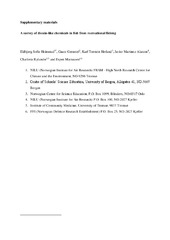| dc.contributor.author | Heimstad, Eldbjørg Sofie | |
| dc.contributor.author | Grønstøl, Gaute | |
| dc.contributor.author | Hetland, Karl Torstein | |
| dc.contributor.author | Alarcon, Javier Martinez | |
| dc.contributor.author | Rylander, Charlotta | |
| dc.contributor.author | Mariussen, Espen | |
| dc.date.accessioned | 2015-10-02T10:18:29Z | |
| dc.date.available | 2015-10-02T10:18:29Z | |
| dc.date.issued | 2015-07-19 | |
| dc.description.abstract | The dioxin and dioxin-like compounds are regarded as one of the most toxic group of environmental
contaminants. Food for the commercial market is regularly monitored for their dioxin levels and the concentration allowed in food is strictly regulated. Less is known about locally caught fish from recreational fishing, which is often brought home for consumption. This can be fish caught from nearby lakes or streams or fish with marine origin close to industrial areas or harbours that are not regularly monitored for their dioxin levels. In this study, we established collaboration with schools
in 13 countries. We received 203 samples of 29 different fish species of which Atlantic cod was the most abundant followed by brown trout and pollock. In general, the majority of samples from the participating countries had low concentrations (between 0.1 and 0.2 pg/g chemical-activated luciferase gene expression toxic equivalency wet weight (CALUX TEQ w.w.)) of dioxins
and dioxin-like PCBs. Only 18 samples had concentrations above 1 pg/g CALUX TEQ w.w., and only 2 dab samples had concentration above maximum levels set by the European Commission. The Atlantic cod samples showed a significant reduction in the concentrations of dioxins with increasing latitude indicating less contamination of dioxin and dioxin-like compounds in the north of Norway. The results indicate that a moderate consumption of self-caught fish at presumed non-contaminated sites does not represent a major risk for exposure to dioxins or dioxin-like compounds at concentrations associated with adverse health effects. Recreational fishermen should, however, obtain knowledge about local fish consumption advice. | en_US |
| dc.identifier.citation | Environmental Monitoring & Assessment, August 2015, 187:509 | en_US |
| dc.identifier.cristinID | FRIDAID 1254758 | |
| dc.identifier.doi | 10.1007/s10661-015-4728-7 | |
| dc.identifier.issn | 0167-6369 | |
| dc.identifier.uri | https://hdl.handle.net/10037/8174 | |
| dc.identifier.urn | URN:NBN:no-uit_munin_7757 | |
| dc.language.iso | eng | en_US |
| dc.publisher | Kluwer Academic/Plenum Publishers | en_US |
| dc.rights.accessRights | openAccess | |
| dc.subject | Dioxins and dioxin-like contaminants | en_US |
| dc.subject | CALUX bioassay | en_US |
| dc.subject | Recreational fishing | en_US |
| dc.subject | Education | en_US |
| dc.subject | Cod | en_US |
| dc.subject | Pollock | en_US |
| dc.subject | Trout | en_US |
| dc.subject | VDP::Matematikk og Naturvitenskap: 400::Zoologiske og botaniske fag: 480 | en_US |
| dc.subject | VDP::Mathematics and natural science: 400::Zoology and botany: 480 | en_US |
| dc.subject | VDP::Agriculture and fishery disciplines: 900::Fisheries science: 920 | en_US |
| dc.subject | VDP::Landbruks- og Fiskerifag: 900::Fiskerifag: 920 | en_US |
| dc.title | A survey of dioxin-like contaminants in fish from recreational fishing. | en_US |
| dc.type | Journal article | en_US |
| dc.type | Tidsskriftartikkel | en_US |
| dc.type | Peer reviewed | en_US |


 English
English norsk
norsk
